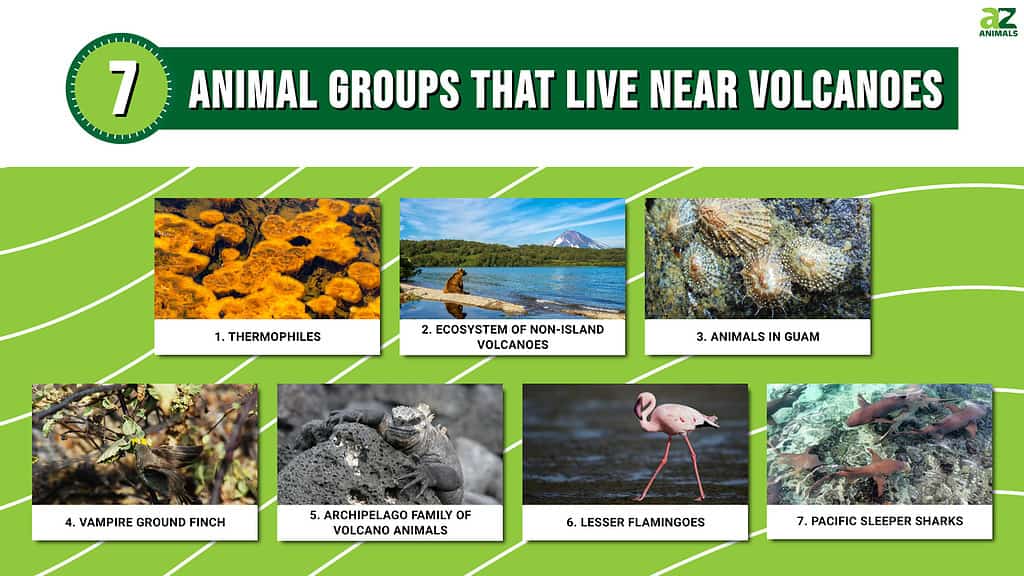
Volcanoes are dangerous and a risky place to call home.
Humankind has daringly settled in the nest of many of these literally explosive environments, and so has a series of incredible animals who don’t merely survive but thrive.
From birds to shrimp, these animals are among the most resilient wildlife in the world. Believe it or don’t but there are actually animals that live inside volcanoes!
Let’s take a look at six groups of animals that call volcanoes home sweet home.
#7 Pacific Sleeper Sharks
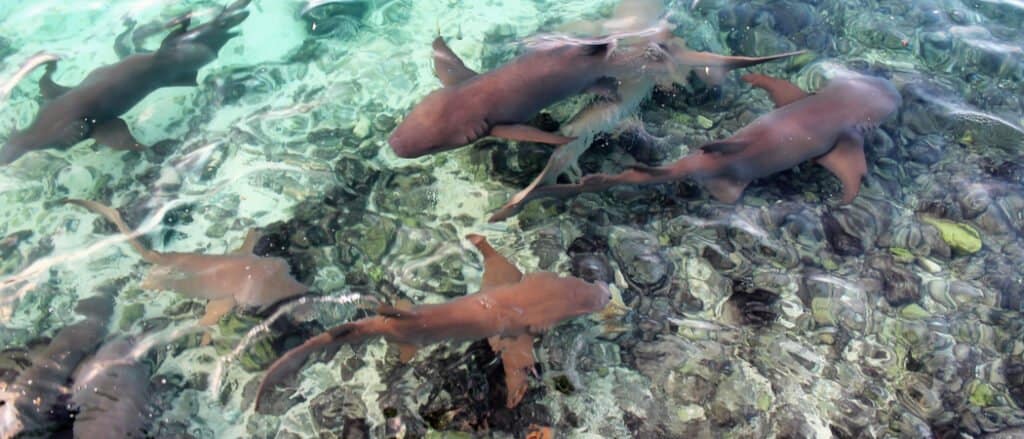
By sending in a robot to document, scientists discovered that
Pacific sleeper sharks
have taken up residency in a volcano.
©shweta.onlinetester/Shutterstock.com
Located in the waters of Mexico and Japan, the Pacific Sleeper shark likes to live deep in waters with minimal visibility.
During an expedition a few years ago, National Geographic found these sharks inside a volcano caldera. The animals were a mere 12 miles from one of the active volcanoes in the southwest Pacific waters.
The water should have been too hot and acidic for the sharks, but there they were.
#6 Lesser Flamingoes
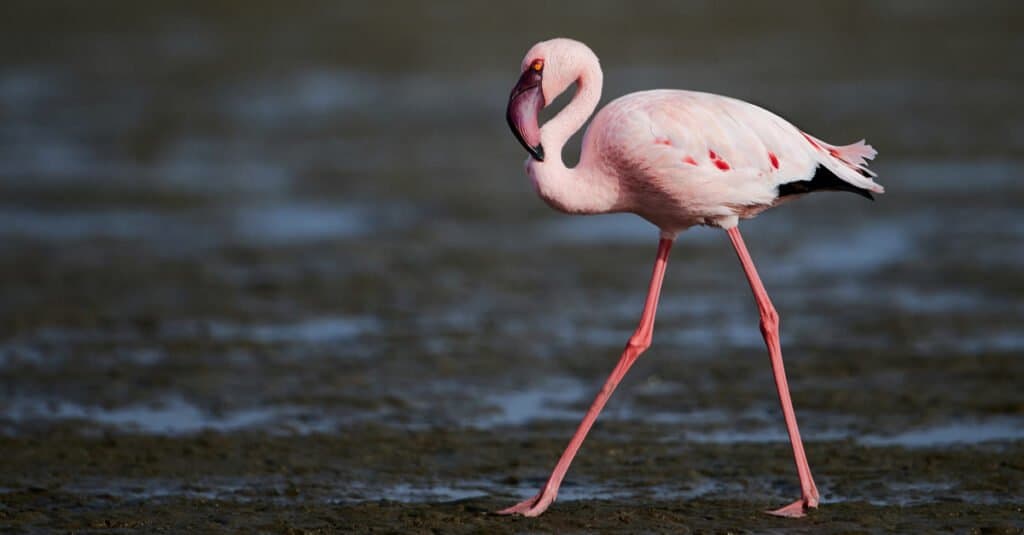
75% of the world’s lesser flamingoes live in Lake Natron in Tanzania, which is deadly and near one of
Africa
‘s most active volcanoes.
©mikex4/Shutterstock.com
In Tanzania is Ol Doinyo Lengai, one of Africa‘s most active volcanoes. It is surrounded by some of the world’s most toxic waters. Their primary breeding grounds are on Lake Natron, an alkaline lake which is extremely caustic. The source of the water is a series of hot springs with very high mineral content. The water is also very hot and often reaches 104 degrees.
The lake is shallow and hot so it suffers from a lot of evaporation, which concentrates the mineral content. The water often reaches a pH of 12, which would be toxic to most life. The ecosystem can damage skin and kill most plants, humans, and animals. Yet, somehow the area has become home to over two million lesser flamingos.
They’ve developed scales on their legs to prevent burning. The birds’ skin is tough as it gets and somehow the animals can drink near boiling point water and — wait for it! — have the capacity to remove elements like salt with their nasal cavities.
The flamingos build nests on local islands and raise their young there. Competition for food is rare and, because of the toxicity in the area, the flamingoes have no worries about predators.
#5 Archipelago Family of Volcano Animals
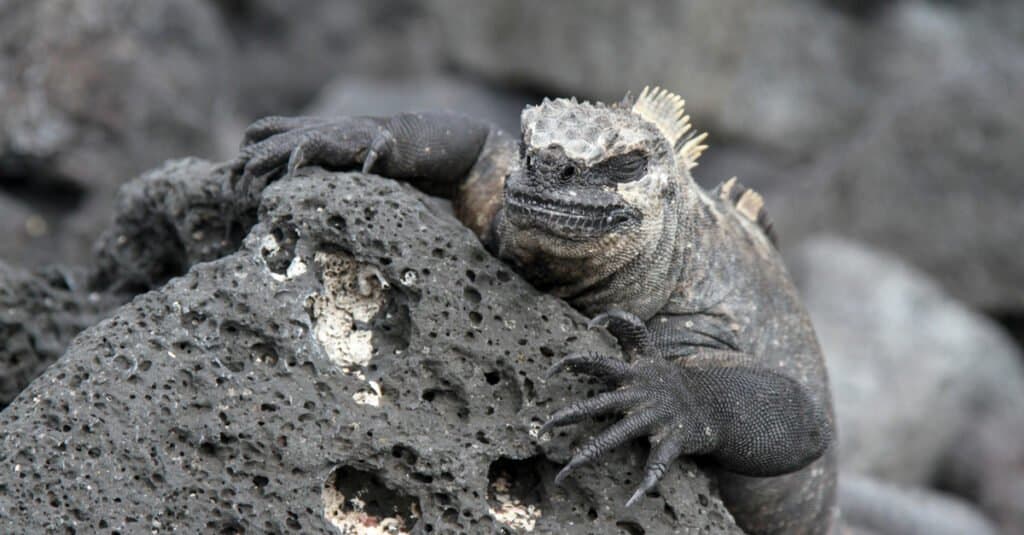
The Galapagos is home to many creatures that have adapted to the lava and heat, including marine iguanas.
©Anastasia Koro/Shutterstock.com
A pristine and very active volcano, Fernandina Island, is one of the Galapagos volcanoes. It’s home to a variety of the Archipelago’s endangered and iconic creatures. We’re talking land and marine iguanas, penguins, flightless cormorants, and sea lions. All of these animals have adapted to living in the remote region.
The female land iguana uses the volcano’s thermal heat to protect her eggs. Yearly, thousands of the lizards take a 10-day trip from the coast to La Cumbre to lay eggs in the warm ash of the volcano. Once they reach the top, the lizards climb down the precipitous sides to the crater floor. At the bottom, the females build nest and drop their eggs into the warm, soft ash. It creates an ideal environment for incubating eggs.
There remains the threat of earthquakes, eruptions, and lava in the area. However, the treacherous terrain and potential risks don’t stop the lizards from nesting inside the crater.
Like many animals, land iguanas have an uncanny ability to sense trouble in their environments. When their instincts warn them of potential volcanic activity, it’s not unusual for them to flee before safety is no longer an option.
#4 Vampire Ground Finch
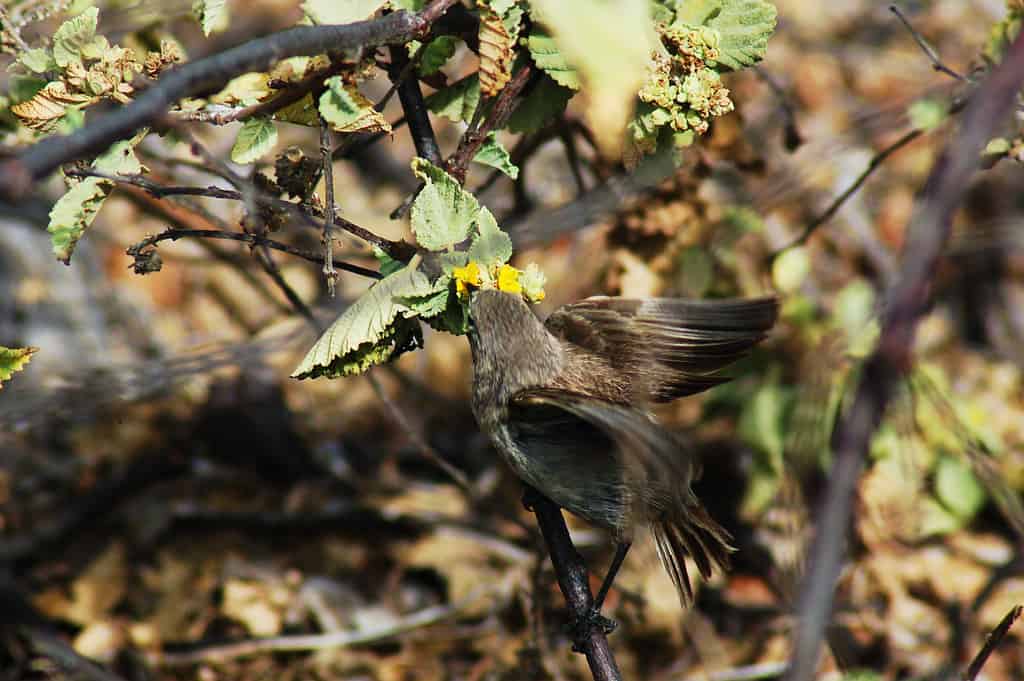
These finches have cleverly adapted to their dire circumstances and are able to survive in the worst conditions.
You’ll find Wolf, a volcanic island in the Galapagos, dry and hot. The animals here suffer from limited food and water supply. During droughts, the finch populace is known to decrease by 90 percent.
These creatures, however, have cleverly adapted to their dire circumstances. Believe it or don’t, they’ve evolved into vampires! It’s a characteristic that allows them to survive in the worst conditions.
The vampire finch has taken to drinking blood to supplement a diet of pulp, cactus nectar, and bird eggs. Another part of their diet is removing parasites from roosting booby seabirds. Before eating the parasites, the finch’s sharp beak pierces the flesh to draw and suck out the blood. The practice provides all the nutrients the finch needs.
Curiously, the vampire’s primary prey, the boobies, don’t put up a lot of resistance. It may be because the vampire finches attack in unstoppable numbers! It may also be that they consider the bite to be a small price to pay to rid themselves of parasites.
The vampire has the largest and sharpest beak of all the subspecies in the sharp-beaked ground finch family.
#3 Animals in Guam

Limpets are one of the many underwater species that live in the ecosystem near Guam’s active volcano.
©A. Mertens/Shutterstock.com
Near Guam is an active undersea volcano. Despite its eruptions and growth, it supports a unique ecosystem of creatures. Animals sustained by the environment include crab, shrimp, barnacles, limpets, and many undiscovered species of animals. They’ve all somehow adapted to a home toxic and flush with harsh chemicals. The Loihi shrimp, for example, grazes for bacterial filament with its tiny claws.
There are other (still unidentified) species of shrimp that graze when young but once achieving adulthood, with enlarged claws, they turn predatory. Marine life that wanders into the volcanic waste die and become food.
Scientists have concluded that because of the high amount of minerals and warmth given off by volcanoes, it actually makes them a breeding ground for a lot of different species that have adapted to the harsh environment.
Shrimp, crab, barnacles, and many other forms of life all call Guam home.
#2 Ecosystem of Non-Island Volcanoes
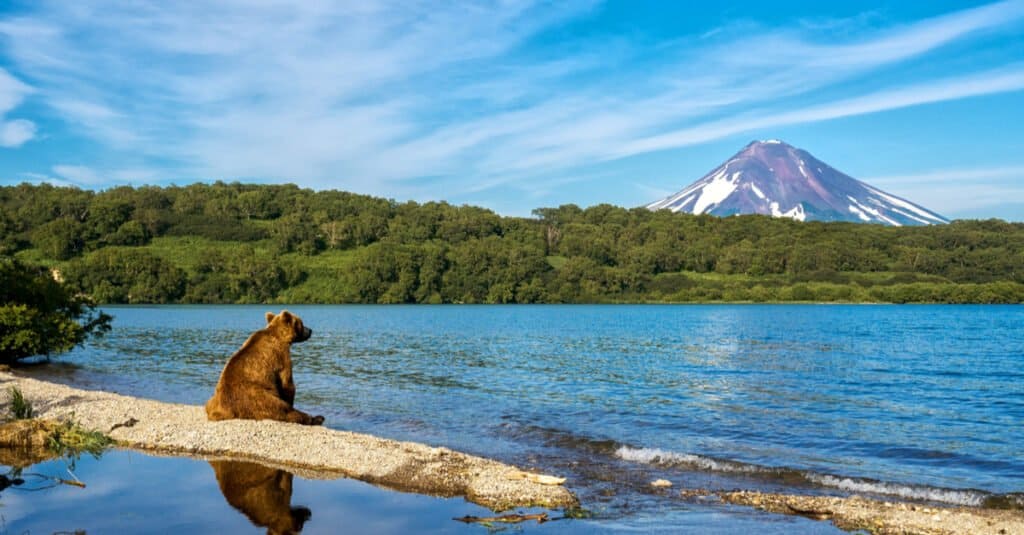
A bear in Russia gazes at the distant volcano.
©Aristov_tmb/Shutterstock.com
The vast majority of volcanoes are either underwater or on islands. If you find a volcano in-country, the wildlife tends to be much more diverse. Animals are able to pass through freely, establishing populations and utilizing the land.
For instance, Mount St. Helens’ surroundings include rabbits, bobcats, mice, bears, and more. Living in flatlands and forests, the creatures can feel changes in the air around them.
They can sense trouble coming from the volcano.
The instinct tends to give them plenty of time to escape an imminent eruption of serious magnitude. This is a trait that appears to be natural among all species that survive in a volcanic location.
#1 Thermophiles
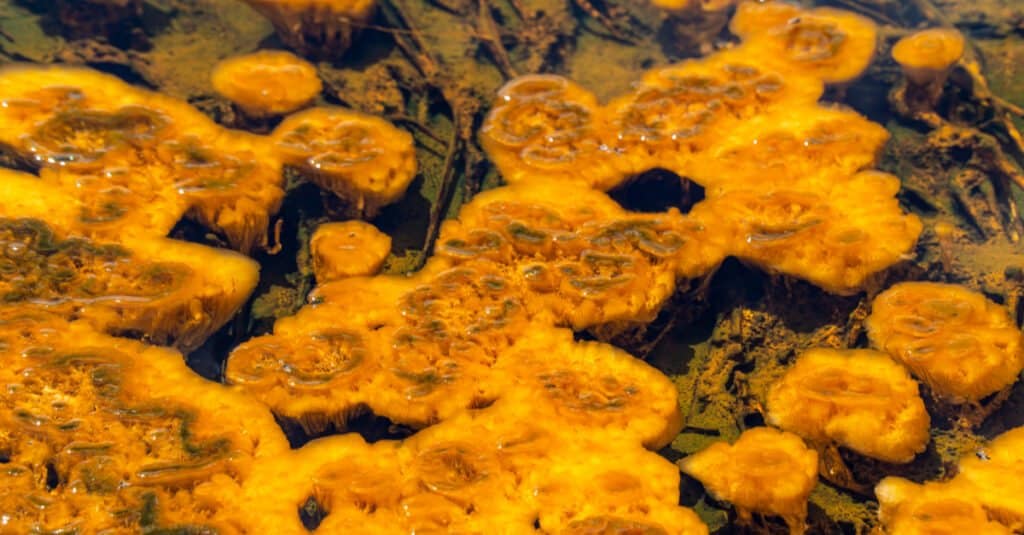
A colony of thermophiles provides insight into the first signs of life on earth.
©GeoNtoH/Shutterstock.com
Thermophiles are basically microorganisms. They live under horrifically hot conditions and can be found near, or in, volcanoes. The hot pools at Yellowstone National Park stay heated by geothermal volcanic activity, often reaching temps above boiling water. These environments are home to thriving thermophilic communities. The organisms have unique enzymes (or extremozymes) that protect them from extreme temperatures.
The thermophile’s known to stroll casually through 252 degrees of heat. Thermophiles play an important role in biotechnology. Two species are sources for enzymes used in DNA fingerprinting.
Researchers also use these organisms to develop an understanding of early Earth. It’s believed life began under harsh temperature conditions. The first organisms may have been thermophiles. The theory helps provide insight into the beginning of life and the possibility of life elsewhere in the universe.
Animals and Volcanoes
Landmasses across the planet are the result of volcanic activity. Volcanoes are vents, allowing magma to leave the Earth’s core. Reaching surfaces, the substance alters the landscapes. Many forms of wildlife developed skills and adaptations that allow them to survive in different volcanic environments.
There are two basic volcano types: underwater or above ground.
Volcanic Underwater Ecosystems
It’s believed there are over one million submerged volcanoes. The majority are extinct or inactive. A curious variety of animals nourish themselves off chemicals released by an eruption. Despite the conditions, their populations thrive and grow. There are shrimp and crabs that feed off the nutrients in hardened lava. Unfamiliar animals that wander into the toxic region end up food as well.
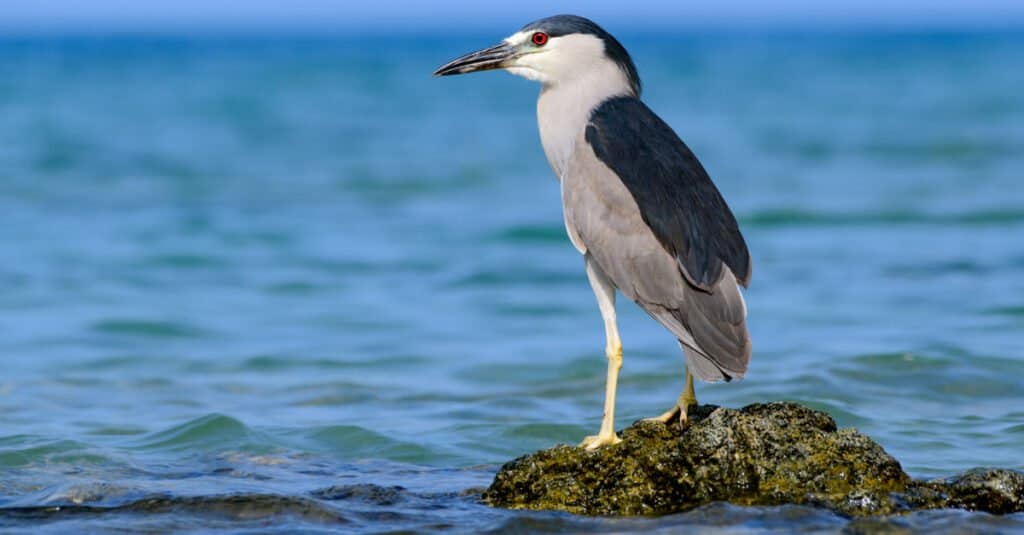
The Hawaiian Black Crowned Night Heron perches on lava rock and hunts for fish in Hawaii’s underwater ecosystem.
©Jeff W. Jarrett/Shutterstock.com
Volcanic Surface-Level Ecosystems
These are primarily ecosystems of plants. Plants of various types do well in eruption sites. You can find grapevines and even coffee. The plants pull nutrients from ash and cooled lava. Plants tend to grow after an eruption with heavy rainfalls. With that rain, animals can return to the region feeling a sense of some normalcy.
Mount St. Helens and the Galapagos Islands are examples of the surface-level volcano’s impact on adaptability after eruptions.
Volcanic Tropical Ecosystem
Hawaii is a prime example of evolution and adaptation. The state has crickets needing new lava flows and exotic birds and carnivorous caterpillars. There are two dozen species of songbirds on the islands with a hefty supply of flowers and insects to feed on.
Remote and fairly isolated, the island’s animal population is mostly made up of creatures that can fly. Local ecologists see rodents, cats, and other domesticated animals as the invasive species here.
Volcanic Non-Tropical Ecosystems
Non-tropical volcanoes consist of structures not located on islands. You can find bears, rabbits, rodents, and bobcats running around.
There are a greater variety of animals in these ecosystems because of their accessibility. Still, animals who settle there evolved to survive in these volcanic locations.
Summary of 7 Animal Groups That Live Near Volcanoes
Animals are incredible and can sometimes thrive in the most unreal locations. Here are 7 animal groups found near volcanoes:
| Number | Species |
|---|---|
| 1 | Thermophiles |
| 2 | Ecosystem of Non-Island Volcanoes |
| 3 | Animals in Guam |
| 4. | Vampire Ground Finch |
| 5 | Archipelago Family of Volcano Animals |
| 6 | Lesser Flamingoes |
| 7 | Pacific Sleeper Sharks |
The photo featured at the top of this post is © Anastasia Koro/Shutterstock.com
Thank you for reading! Have some feedback for us? Contact the AZ Animals editorial team.







